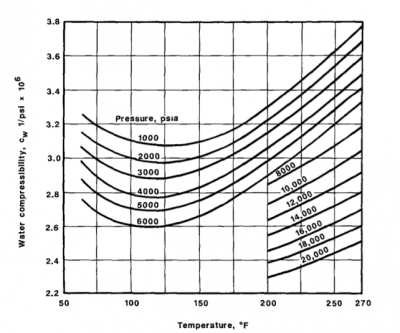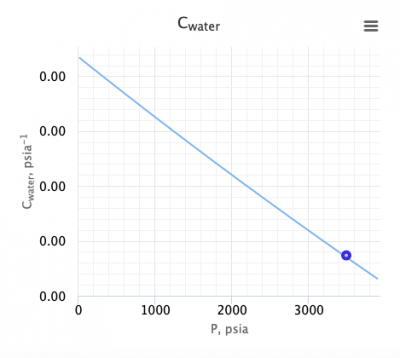Difference between revisions of "Water compressibility"
From wiki.pengtools.com
(→Example. Calculating water isothermal compressibility) |
|||
| Line 27: | Line 27: | ||
===Solution=== | ===Solution=== | ||
:<math> c_w = 2.6348E-6\ psia^{-1}</math> | :<math> c_w = 2.6348E-6\ psia^{-1}</math> | ||
| + | |||
| + | The solution is also available in the PVT software model at [The solution is available in the PVT calculator software model at [https://www.pengtools.com/pvtCalculator?paramsToken=d0f0c9c587152cefc27d1217e091ace0 www.pengtools.com] | ||
== Nomenclature == | == Nomenclature == | ||
Revision as of 06:52, 5 October 2020
Contents
Water compressibility
The formation water (brine) isothermal compressibility data is published in 1990 by McCain[1].

Water compressibility data [1]
Math and Physics
At pressures above bubble point:
Application range
The correlation is valid only for temperatures between 200 and 270F, pressures of 1000 to 20000 psia, and salinities up to 200000 mg/l[2].
Discussion
We, at pengtools.com, are calculating water compressibility below the bubble point with the same equation at the moment.
Example. Calculating water isothermal compressibility
Example source [1]
Input data
Calculate water isothermal compressibility at 3500 psia and 165°F?
Solution
The solution is also available in the PVT software model at [The solution is available in the PVT calculator software model at www.pengtools.com
Nomenclature
 = pressure correction, res bbl/STB
= pressure correction, res bbl/STB = water salinity or solids concentration, mg/l
= water salinity or solids concentration, mg/l = pressure, psia
= pressure, psia = Temperature, °F
= Temperature, °F
See also
- Water bubble point pressure
- Water compressibility
- Water density
- Water formation volume factor
- Water salinity from density equation
- Water solids concentration
- Water viscosity
References
- ↑ 1.0 1.1 1.2 McCain, W.D. Jr. (1990). Properties of Petroleum Fluids (2 ed.). Oklahoma: PennWell Corp. ISBN 978-0878143351.
- ↑ 2.0 2.1 McCain, W.D. Jr. (1991). "Reservoir-Fluid Property Correlations-State of the Art"
 . Society of Petroleum Engineers (SPE-18571-PA).
. Society of Petroleum Engineers (SPE-18571-PA).




